A modular helmet features a hinge system that allows the chinbar to lift open effortlessly with the touch of a release button on the front, effectively transforming it into an open-face configuration for added comfort and convenience. But with the chinbar closed, you benefit from the safety and noise reduction of a full-face helmet. Modular helmets meeting the latest ECE 22.06 standard are dual homologated to P and J — as a ‘Jet’ (open face) and with a ‘Protective’ chin guard (full face). In simple terms, this means they’re designed to be safely ridden with the chin bar open or closed. You don’t want it inadvertently opening or closing in front of your face while riding!
Nonetheless, it’s quite probable that I’ll find myself in situations where I’ll need to flip open the front of my helmet at a gas station, grab a quick drink, ask for directions, engage in casual conversation with friends, or simply savor the refreshing breeze and breathtaking scenery along the picturesque Beartooth Highway at speeds below 50 mph.
But should you choose to exceed my speed limit, traditional modular helmets tend to pivot the chin bar upright at a 45 or 90-degree angle, potentially turning it into a sail that uncomfortably tugs and twists your head. Fortunately, modern designs, especially those from Shark and LS2, now feature a complete 180-degree flip over the back, resulting in a much sleeker and aerodynamic profile during rides—an experience I’ve cherished throughout my my more 50 years of motorcycling. And when it comes to the best modular helmets under $300, trust me, I’ve got the expertise:
| Helmet Model | Category | Chin Bar Rotation | Get Yours |
| HJC C91 | Best All-Round | 45° | RevZilla | Amazon |
| Sedici Sistema II | Best Entry-Level | 90° | RevZilla | CycleGear |
| LS2 Valiant | Best Everyday Commuter | 180° | RevZilla | Amazon |
| BILT Techno 3.0 | Best Sport-Touring | 45° | RevZilla | CycleGear |
| Sena Outrush R | Best Bluetooth-Ready | 90° | RevZilla | Amazon |
Before I delve deeper into these selections, let me first explain the criteria that guided my choices.
Considerations When Choosing the Perfect Modular Helmet
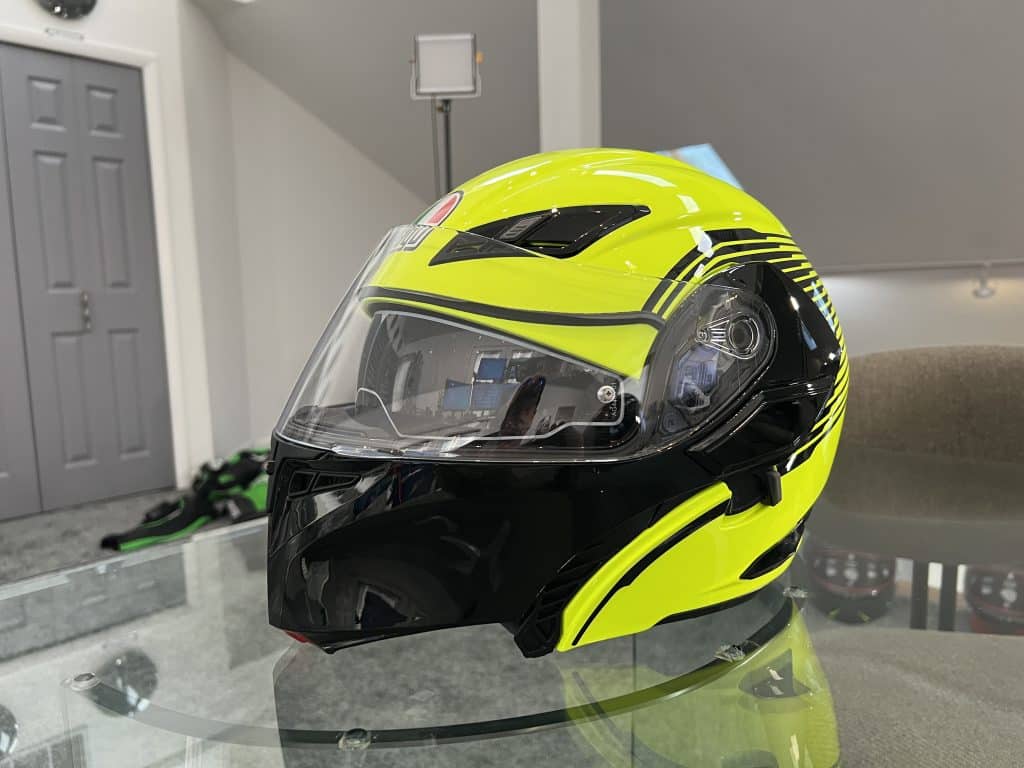
When searching for the best modular helmet, there are several factors to take into account beyond just the outer shell construction, which often entails polycarbonate for models under a $300 price tag. The pivot locking system, ventilation, inner padding, visors, and chin straps all play pivotal roles in ensuring both comfort and safety.
I’ve extensively covered these factors in my article “Top 5 Best Modular Helmets: The Best Of Both Worlds.“
And let me throw in a little extra tidbit:
A Retractable Sun Visor Is a Must-Have
Internal sun visors are like the cherry on top of the best modular helmets, providing the ultimate convenience of having sunglasses built right in. They’re there when you need them, easily flipping down with a flick of your finger. A feature that’s especially handy compared to full-face helmets, where I constantly find myself switching between clear and tinted visors to shield my eyes from the sun.
Homologation
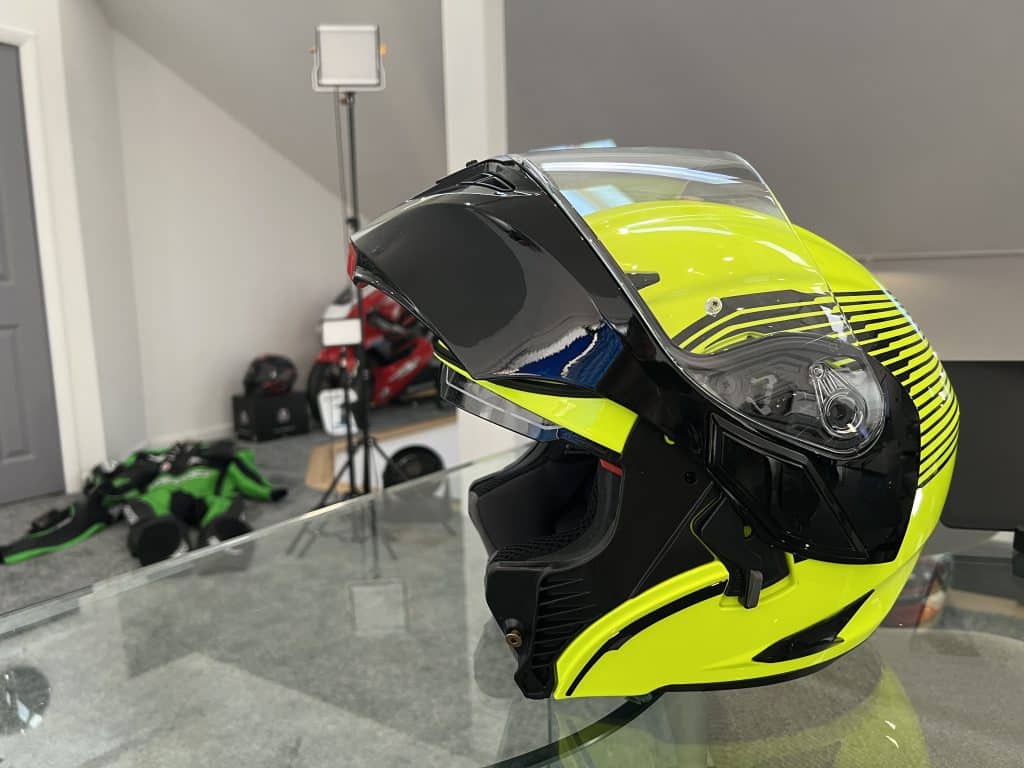
Back in the day, modular helmets were only given the green light for full-face use according to the outgoing ECE 22.05 standard. Yep, I’m guilty too—I’m sure I’m not the only one—who often used the flip-up feature despite it being technically against the rules.
The introduction of the ECE 22.06 rating standard addresses this issue. Now, helmets are dual-homologated to P (full face) and J (open face/jet) classifications, making life easier for us riders. Basically, any modular helmet with that ECE 22.06 stamp means we can ride with the chin bar up or down, giving us more options and keeping us on the right side of safety regulations.
I get it, the ECE helmet safety standard is mainly a European thing, not so much a deal stateside. But for me, it still carries a lot of weight because of its rigorous testing procedures, including testing impacts from all angles—front, top, back, and sides. Compare that to the DOT certification, which is more of a bare minimum requirement for products sold in the US and Canada. It just doesn’t have the same thorough testing as the ECE standard.
Top 5 Best Modular Helmet Under $300 in 2025
| Helmet Model | Category | Chin Bar Rotation (Angle) |
| HJC C91 | Best All-Round | 45° |
| Sedici Sistema II | Best Entry-Level | 90° |
| LS2 Valiant | Best Everyday Commuter | 180° |
| BILT Techno 3.0 | Best Sport-Touring | 45° |
| Sena Outrush R | Best Bluetooth-Ready | 90° |
To cater to the varying needs of budget-conscious riders, I’ve organized my picks into five distinct categories: best all-round, best entry-level, best everyday commuter, best sport touring, and best Bluetooth-ready. I understand that the modular helmet market can be overwhelming, with numerous options vying for attention.
Rest assured, my recommendations stem from personal encounters with each helmet. With 48 years of helmet industry expertise and hands-on riding experience as of today, I offer insights grounded in firsthand knowledge rather than hearsay. Here we go:
1. HJC C91: Best All-Round
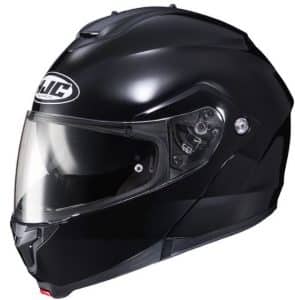
Continuing the legacy of an all-rounder modular helmet suitable for both daily commutes and extended tours, the C91, introduced in 2020, builds upon the success of its forerunner, the C90. Notably, the C90 adhered to the DOT, ECE 22.05, and SHARP 4-star safety standards. Its chin bar demonstrated an impressive 87% retention rate through more than 150 impact tests conducted across various sections of the helmet during the 8.5 m/s linear impact trials against the flat anvil.
The C91 maintains this standard with its user-friendly single-button chin bar mechanism, effortlessly raising to approximately a 45-degree angle. But it still lacks dual homologation (P/J), meaning it’s not ECE 22.06 approved for riding with the chin bar open. Despite this limitation, operating the chin bar is straightforward, and it lifts smoothly out of the field of vision.
While not flashy and made from exotic materials, the C91 has undergone a significant redesign compared to its predecessor, c90, featuring a sleeker advanced polycarbonate composite shell with more angular lines while delivering comparable features and value.
That means decent venting that starts with HJC’s Advanced Channeling Ventilation System (ACS), consisting of a single top vent operated by a small slider and a single chin bar vent controlled by a larger slider panel. The top vent directs airflow through channels in the helmet shell to circulate around the head, while the chin bar vent directs air towards the mouth and the back of the visor.
But relying solely on the chin vents may not suffice to prevent visor fogging in adverse weather conditions. That’s why I’ve opted to fit a Pinlock for enhanced ventilation. Luckily, the C91 comes with a Pinlock-ready face shield.
The face shield operates smoothly on a ratchet system, with the opening tab conveniently located on the left side. Offering 99% UVB and UVA protection, the shield ensures a clear and protected view while riding.
Adding on that, the medium-tinted and antifog-coated drop-down sun visor, which is manually operated (a preference of mine over auto-return springs to avoid premature wear and tear) via a slider on the helmet’s top, eliminates my need for cumbersome sunglass swapping or dark visor changes. Regardless of the brightness of the sun, I can ride confidently knowing that I’m well-protected. Moreover, its integration with HJC’s own headset and compatibility with aftermarket Bluetooth units ensure versatility and convenience during my rides.
Inside the C91, you’ll find a comfortable SuperCool lining that becomes even more comfortable with use. The lining is moisture-wicking and anti-bacterial, complemented by speaker pockets and glasses grooves for added convenience, especially for us who wear glasses.
It’s all securely fastened to your head with a convenient and user-friendly micrometric fastener.
2. Sedici Sistema II: Best Entry-Level

The Sedici Sistema II modular helmet is a well-executed update to its predecessor, the Sedici Sistema, addressing the concerns of budget-conscious riders without skimping on quality. The decision to revamp the helmet has yielded impressive results, especially considering the original Sistema’s shortcomings in comfort, noise levels, and overall refinement.
But now, with the Sistema II, Sedici (a house brand of Cycle Gear/Revzilla, both part of the Comoto Holdings group) is stepping up its game. They’re so confident in its quality that they assert,
“We offer a Lifetime Guarantee on materials, workmanship, and performance—pretty rare in the world of motorcycle gear.”
And despite its impressive tech specs, like fancy fiberglass/Kevlar in the Sistema line helmets or carbon fiber/Kevlar shells in the Strada line, Sedici keeps prices low by cutting out middlemen. That means we riders get more bang for our buck.
Speaking of tech specs, the Sistema II doesn’t disappoint. Its aerodynamic shape, made from a blend of fiberglass and DuPont™ Kevlar®, is designed to cut through the wind with ease, giving you a smooth ride even at speeds over 70 mph. The reinforced hinge and polycarbonate chin bar mechanism, similar to the HJC C91, further enhance the helmet’s durability and safety, providing you with confidence and peace of mind on the road.
Underneath the robust shell lies a complex EPS structure with 4 different densities (XS-SM, MD, LG- XL, 2XL-3XL), providing solid protection while maintaining a remarkable lightness of just 3.7 pounds (1,678 grams). Compared to premium alternatives like the Shoei Neotec II, which weighs 3.82 pounds (1,736 grams) in medium size, the Sistema II offers a slightly lighter option without sacrificing durability.
But it’s not just about looks and weight—the Sistema II is all about comfort, too. Its advanced ventilation system, featuring enlarged intake vents, chin vents, and rear exhaust vents, keeps you cool and comfortable no matter how fast you’re going. Plus, the moisture-wicking interior, treated with antimicrobial goodness, can be easily removed and washed to keep things fresh.
And if you’re riding in bright sunlight, just deploy the sun visor with a glove-friendly swipe—just remember, it’s not for night use.
To address noise concerns of its predecessor, which was a bit loud, the Sistema II comes equipped with a chin skirt to help seal off the bottom of the helmet and reduce wind noise, although I still recommend wearing earplugs for added peace and quiet.
3. LS2 Valiant: Best Everyday Commuter
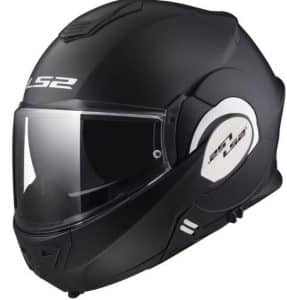
I must first mention that both the original LS2 Valiant and its successor, the Valiant II, have been discontinued, although they are still available for purchase. LS2 has introduced a new model, the Advant X, which is ECE 22.06 certified and offers a fresh design that won’t raise eyebrows like its predecessors with Shark.
But for today, I’ll focus on the original Valiant—my top pick for everyday rides and commutes, especially considering its sub-$300 price tag ($299.98 as of this review), which is approximately $60 more than the Valiant II and $130 more than the Advant X.
Having owned both the Shark Evoline and Shark Evo-One 2 modular helmets in the past, I couldn’t help but notice the striking resemblance they share with the LS2 Valiant. Not only does it have a similar design aesthetic, but it also meets the ECE dual-homologation, allowing the chin bar to rotate a full 180 degrees, giving you that authentic three-quarters helmet experience.
Furthermore, it has been through rigorous SHARP testing and scored an impressive 4-star rating overall, with the chin bar staying securely locked 97% of the time—stellar marks for a modular lid.
Despite finding the recessed button under the front a bit awkward to operate with my winter gloves on, requiring a firm press, I must say, the transition from full-face to open-face (and vice versa) on the LS2 Valiant is flawless. It’s smooth as butter, never sticking, and locks closed with zero effort, accompanied by a satisfyingly solid click.
In fact, I’d go as far as saying it outperforms the Shark Evo GT, which has a tendency to jam and often fails to lock properly unless you pinch it closed with your finger and thumb.
The shield on the Valiant is top-notch—it’s a class A optically correct shield, meaning it’s distortion-free, ensuring you always have a crystal-clear view of the road ahead. Operating on a ratchet system, it took me a bit of getting used to, especially with the opening tab positioned top-center, but once I got accustomed to it, I appreciated the convenience. Plus, it’s wider than the average shield, providing excellent peripheral vision—a definite plus.
In the US, it’s Fog Fighter anti-fog prepared straight out of the box. In Europe, it’s even better—it comes to Pinlock-ready, with a Pinlock Max Vision anti-fog insert included, ensuring your vision remains clear no matter the weather conditions.
What’s more, like its Shark counterparts, the Valiant features a thermoplastic shell—LS2 calls it a Kinetic Polymer Alloy, but don’t let the fancy name confuse you; it’s still a polycarbonate shell. While the Valiant is only available in two shell sizes, it makes up for it with a multi-density polystyrene lining, offering progressive shock absorption during impacts.
Ventilation-wise, you get a useful chin vent featuring a 2-way open/close slider for venting to the back of the visor. There’s also a crown vent, again with a 2-way slider, designed to channel air through the helmet shell and cool the top of your head. At the back, you’ll find four separate exhaust vents to whisk away warm, stale air and make room for fresh air to flow in.
But when you peek inside the helmet, you’ll notice that there isn’t as much opportunity for air to make its way through the comfort lining compared to other helmets. While most manufacturers incorporate large cut-aways or mesh panels into the lining for better airflow, the Valiant’s liner is more solid in design.
One unique feature of the Valiant is its fastening system—a micrometric 2 chin strap, which utilizes a micrometric fastener with a metal ratchet instead of the old plastic version.
4. BILT Techno 3.0: Best Sport Touring
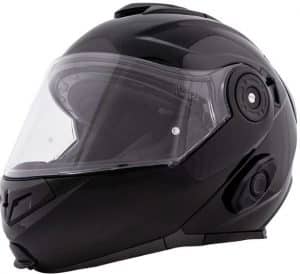
The Bilt Techno 3.0 was my go-to budget Bluetooth modular helmet until Sena swooped in and stole the spotlight in 2021 with the Sena Outrush R (check out my review below). Why the switch? Well, Bilt managed to cram everything you need for music and comms into one incredibly practical and functional lid. From the oversized chin bar flip-up lever to the straightforward controls, it’s about as sport touring-friendly as it gets!
As I mentioned, the Bilt Techno 3.0 comes with a budget-friendly price tag, so you won’t find any high-tech carbon fiber composite shell features like you might see in MotoGP helmets (I mean, c’mon, I’m all about that AGV Pista GP RR life, haha). Instead, what you get is pretty straightforward—Bilt refers to it as an “injection molded alloy composite,” which is essentially just a fancy term for plastic.
And in terms of sizes, there are only two shell sizes available, covering XS-2XL and then 3XL-5XL. You might find a better fit if you’re in the middle range, while those at the extremes may experience thin padding or a slightly oversized appearance.
| Size | Head (in) | Head (cm) |
| 2XS | 20.1-20.5 | 51.1-52.1 |
| XS | 20.9-21.3 | 53.1-54.1 |
| SM | 21.7-22.0 | 55.1-55.9 |
| MD | 22.4-22.8 | 56.9-57.9 |
| LG | 23.2-23.6 | 58.9-59.9 |
| XL | 24.0-24.4 | 61-62 |
| 2XL | 24.8-25.2 | 63-64 |
| 3XL | 25.6-26.0 | 65-66 |
| 4XL | 26.4-26.8 | 67.1-68.1 |
| 5XL | 27.0-27.5 | 68.6-69.9 |
Oh, and a little heads up—these sizes tend to run on the small side, so it’s probably wise to go up a size from whatever you measure on their size chart and then double-check to make sure you’ve got the right fit for your noggin.
As for the airflow, you’re looking at just two vents on this lid—one at the chin bar and one on the top of the head. It’s pretty par for the course for a modular helmet with a flip-up chin bar, providing enough ventilation to keep you comfortable but nothing too impressive.
On the inside, much like any other helmet priced over $50, you’ll find a removable, washable lining made of moisture-wicking material. But where the Bilt Techno 3.0 stands out is in its sun visor and chin bar areas.
The sun visor lever is conveniently located behind the chin bar hinges for easy access. To lift the chin bar, there’s an exterior lever—a departure from traditional designs, but it’s more user-friendly and allows for a full chin curtain for wind noise reduction. Meanwhile, the face shield has four positions, forms a good seal to minimize wind noise, and is Pinlock ready (Pinlock lens sold separately). I always recommend a Pinlock lens for fog-free riding.
But its Bluetooth sound and communication system are what make it shine. Equipped with a Sena DWO-6 With Bluetooth 4.1 headset (equivalent to standalone Sena 10R kits), you can enjoy 10 hours of battery life, connectivity for up to four riders, and a range of 6/10 of a mile.
Built-in speakers and a microphone ensure clear communication, while a discreet control unit maintains the Bilt Techno 3.0’s sleek design. An iOS and Android app with upgradeable firmware adds continuous features at no extra cost
5. Sena Outrush R: Best Bluetooth-Ready
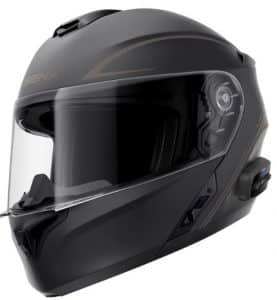
Choosing the Sena Outrush R over the BILT Techno 3.0 as my top pick for the best budget Bluetooth modular helmet boils down to one key factor: Bluetooth version compatibility. While the BILT employs Bluetooth 4.1 technology, the Sena features Bluetooth 5.0, akin to what you find in the pricier Sena Impulse, albeit with a slightly less polished fit and finish.
Bluetooth 5.0 offers faster speeds compared to Bluetooth 4.1, with a format featuring 2Mbps, twice the speed of Bluetooth 4.0 at about 1 Mbps. An enhancement that enables Bluetooth 5.0 to meet the requirements of IoT (Internet of Things) devices, owing to its 5Mbps bandwidth compared to Bluetooth 4.1’s 2.1 Mbps.
The Sena Outrush’s Bluetooth and audio system are perfectly integrated, with a compact control unit situated on the left side featuring intuitive buttons for volume adjustment, track control, call management, and intercom functions. A streamlined design that allows for a larger battery capacity, providing an impressive 12 hours of talk time with just 2.5 hours needed for a full charge.
And when it comes to intercom capabilities, the Outrush R doesn’t disappoint, offering a range of 0.56 miles (900 meters) between riders, with the ability to connect up to 4 riders simultaneously. Furthermore, the helmet features voice prompts (compatible with Siri and Hey Google) for convenient control and incorporates Sena’s Advanced Noise Control to minimize engine and wind noise interference, ensuring crystal-clear communication and audio playback.
Externally, the Sena Outrush R shares similarities with its pricier counterpart, the Sena Impulse, featuring a polycarbonate plastic shell instead of fiberglass and omitting features like a tail light. Ventilation-wise, the Outrush mirrors the Impulse, offering a single chin bar vent and one top vent, though the small vent holes may limit airflow, particularly for a modular helmet.
The chin bar operates smoothly via a button located under the chin, and a chin curtain is included to minimize wind noise. But the Outrush utilizes a ratchet chin strap instead of the double-D, despite securing an ECE safety certification in addition to the standard DOT approval.
Internally, the helmet impresses with its multi-density EPS foam, typically found in higher-priced AGV Sportmodular and Shoei Neotec 3 lids. The removable and washable liner offers comfort and ample padding, ensuring a snug fit without causing discomfort. The face shield features multiple opening positions for airflow regulation and includes a convenient notch at the front to keep it securely locked down—a detail often overlooked in helmets of this price range.
Meanwhile, the integrated sun visor adds convenience, although I did note a slight distortion caused by the ridge at the bottom.
Information for this article was partially sourced and researched from the following authoritative government, educational, corporate, and non-profit organizations:
Ni/A












